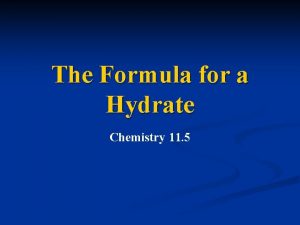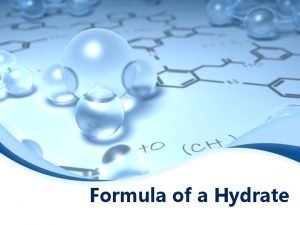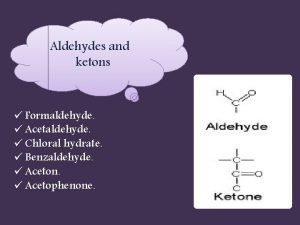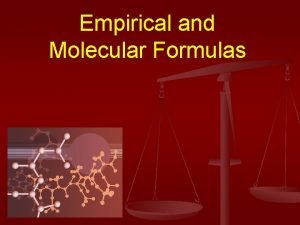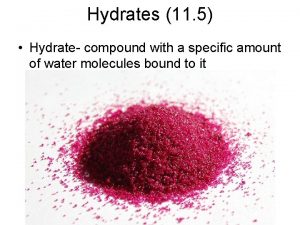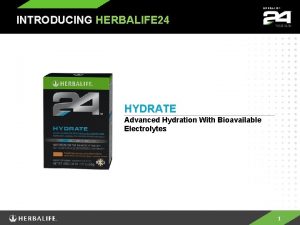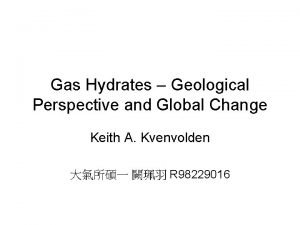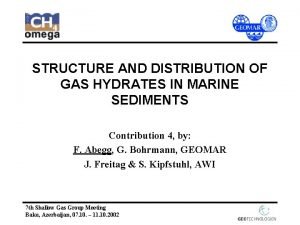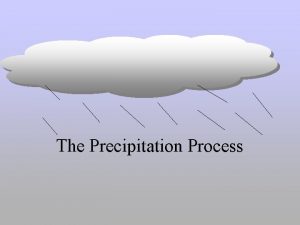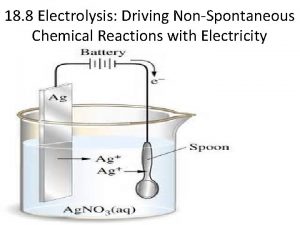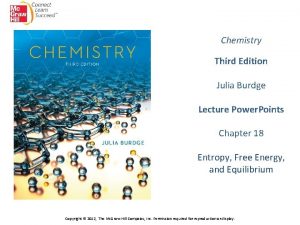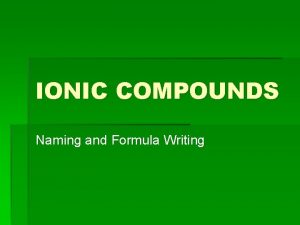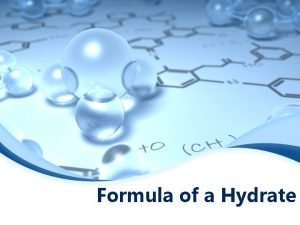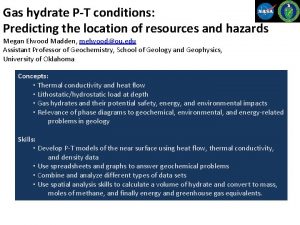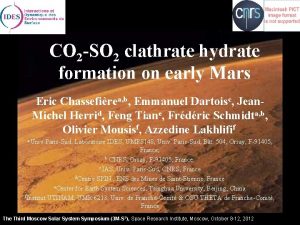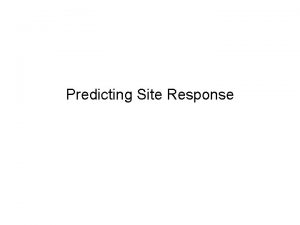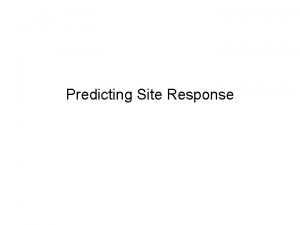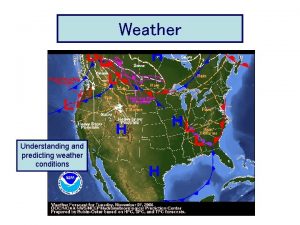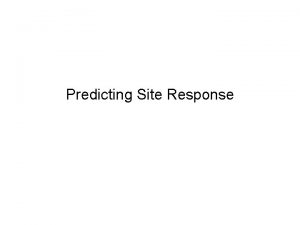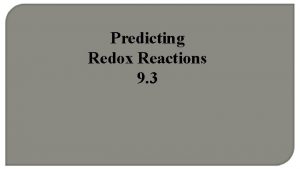1 Practical Methods for Predicting Hydrate Formation during



















- Slides: 19

1 Practical Methods for Predicting Hydrate Formation during Gas Well Testing in Ultra-Deep Water 10 th September 2014 Alex Lowden Academic Supervisor: Alain Gringarten Industry Supervisor: Tim Whittle (BG Group)

Deepwater Oil & Gas Discoveries 2013/14 Block/prospect, Operator, Year, Water Depth > 3, 000 ft Cyprus Gas: Block 12 (Aphrodite), Noble – 2013/5, 574 Canada Oil: Harpoon, Statoil – 2013/3, 630 Oil: Bay Du Nord , Statoil – 2013/3, 874 2 India Gas: Block CYD 5, Cauvery Basin, Reliance – 2013/5, 717 South China Sea Gas: Lingshiu 17 -2, CNOOC – 2014/11, 512 Cote d’Ivoire Oil: Block CI-100, Total – 2013/7, 400 Malaysia Gas: Block SK 318, Shell – 2014/6, 963 Gulf of Mexico Oil: Shenandoa, Anadarko – 2013/ 5, 800 Oil: Coronado, Chevron – 2013/6, 127 Oil: Gila, BP – 2013/4, 900 Oil: Dantzler, Noble – 2013/6, 580 Oil: Block 525, Shell – 2014/7, 479 Oil: Exploratus-1, Pemex – 2014/8, 202 Oil: Maximino, Pemex – 2013/9, 570 Israel Gas: Tamar SW. Noble – 2013/17, 420 Gas: Karish Alon C, Noble – 2013/5, 742 Brazil Oil: Block BM-S-50, Petrobras – 2013/6, 183 Oil: BM-POT-17 Block, Petrobras – 2013/5, 712 Gabon Gas: Diaba License G 4 -223, Total – 2013/5, 673 Congo Oil/Gas: Marine 12, Eni – 2013/9, 882 Mozambique Gas: Area 4, Alguha, Eni – 2013/8, 537 Gas: Area 4, Coral, Eni, 2013/6, 676 Gas: Area 1, Orca, Anadarko – 2013/3, 481 Angola Oil/Gas: Block 20, Sonangol, BP – 2014/12, 703 Tanzania Gas: Tangawizi-1, Statoil – 2013/7, 544 Gas: Mronge-1, Statoil – 2013/8, 200 Gas: Taachui-1, BG – 2014/3, 270 Gas: Piri, Exxon – 2014/7, 440 Gas: Ngisi-1, Mkizi 1 -3, BG – 2013&2014 /4, 600 -5, 900

What Are Gas Hydrates? 3 • Crystalline solid compounds • Stabilised by encapsulating a low molecular weight guest molecule • Growth occurs in the presence of water/gas • At low temperatures and elevated pressures http: //i. ytimg. com/vi/n. Uluh. Ia-hz. A/0. jpg. Accessed 01/09/14

4 The Problem: Hydrate formation during gas well testing in deep and ultra-deep water

5 The Problem: Hydrate formation during gas well testing in deep and ultra-deep water The Solution: To provide a fast and reliable method to predict gas temperatures during well testing

Presentation Workflow 6 1 The Deepwater Environment 2 Modelling temperature during a Shut-in Period A) B) 3 4 Theory Programme Development and Testing Modelling temperature during a Flowing Period A) Theory B) Programme Development and Testing Field application

The Deepwater Environment 7 Sea Current Velocity, m/s Ocean Temperature, C 0 500 Depth, mss 1000 1500 2000 2500 3000 0 4 8 12 16 20 24 0 0. 2 0. 4 0. 5

Presentation Workflow 2 8 Modelling temperature during a Shut-in Period A) Theory • B) Analytic solution Programme Development and Testing

9 Theory: Shut-in Period A solution for the temperature at any point in the riser as a function of shut-in time • As seawater flows around the riser: Boundary layer Sea Current Direction • Multi-layer composite cylinder • Transient heat conduction in the radial direction • Heat transfer to the surrounding ocean by forced convection Gas hydrate formation typically starts at a gas-water interface

10 Theory: Shut-in Period How is heat transferred from the gas to the surrounding ocean? 1. Production tubing and outer riser 2. Condensate water layer 3. Riser Annulus Multilayer conduction problem Condensate Water Layer Gas + Condensate Water • Using a Green’s function approach to derive a solution to this problem

11 Theory: Shut-in Period How is a solution obtained? Condensate water layer Annulus fluid Condensate Water Layer Gas + Condensate Water Multilayer conduction problem

Programme: Shut in Period Programme tested against transient data from a DST conducted in deepwater • Calculated temperatures are within +-5% of gauge data for all shut-in periods Within 4 minutes, a well test planner can predict gas temperatures for a shut-in operation 12

Presentation Workflow 3 13 Modelling temperature during a Flowing Period A) Theory • B) New approach to improve the accuracy of existing heat transfer calculations Programme Development and Testing

Theory: Flowing Period • Methods of solving this equation in the literature make a number of assumptions • Solving this equation using numerical integration RK-4 Numerical Integration Hasan et al (2005) Analytic Solution Can this numerical method be used to create a programme? 14

15 Theory: Flowing Period Approach: numerically solve for the fluid temperature and pressure • Run time for each temperature and pressure traverse is less than a minute 0 Ho urs 0 4 H ou rs 0. 5 Ho urs 0. 5 4 H Ho ou urs s ur Ho rs Well test planners can use this programme to quickly check if operating conditions are within the hydrate formation region

Programme: Flowing Period • To test the programme, transient temperature profiles were calculated for flowing periods of the DST Gauge Depth • Comparison with dynamic multiphase flow simulator +-10% The accuracy of this programme is verified against field data and calculations from OLGA 16

Presentation Workflow 4 Field application • Gas hydrates formed during a flowing period of the DST 17

Gas Hydrate Formation • Flowing gas temperatures over the length of the well: Well Configuration 18 rs r ou rs ou ou 5 H 2 H 1 H

19 Summary 1) A theory has been developed to better predict gas temperatures during well testing in an offshore environment 2) From this theory, programmes have been developed that allow reliable gas temperature profiles to be computed on a spreadsheet, in a short time frame
 Hydrate formula chemistry
Hydrate formula chemistry Anhydrate formula
Anhydrate formula Formaldehyde iodoform test
Formaldehyde iodoform test How to find formula of hydrate
How to find formula of hydrate Hydrate sentence
Hydrate sentence Water percentage composition
Water percentage composition Herbalife hydrate
Herbalife hydrate Methane hydrate definition
Methane hydrate definition Azerbasjan
Azerbasjan Formation initiale vs formation continue
Formation initiale vs formation continue Metal coping fpd
Metal coping fpd Bergeron process
Bergeron process Metal resistance to share during chip formation is known as
Metal resistance to share during chip formation is known as Predicting products of electrolysis
Predicting products of electrolysis Predicting products
Predicting products Predicting spontaneity
Predicting spontaneity Predicting pip
Predicting pip Chemistry predicting products
Chemistry predicting products Predicting fraud
Predicting fraud Predicting and naming ionic compounds
Predicting and naming ionic compounds
